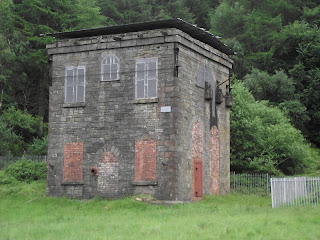Cornish engine in Wales - Glyn Pits, near Pontypool
 |
| This is how the Cornish engine looks today |
We have plenty of engine houses in Cornwall but very few contain their engines. When the mines were worked out (or knacked, as we say down here) the engines were often moved to new locations and could almost be said to be portable - but only with a lot of effort involving teams of horses, oxen and latterly traction engines. Anyone wishing to know more about this should Jack Trounson's Cornish Engines and the Men Who Handled Them.
After the coal mine closed in 1932, the engines at Glyn Pits remained in situ for maintaining neighbouring mines by the National Coal Board, albeit electric pumps were in operation by the time the site was finally abandoned in 1966. They are now a little out off the beaten track for tourists. I was determined to find them and had brought with me The Surviving Engines of Glyn Pits, Pontypool by Gwyn Tilley.
But - and it was a big but - the old maps in this excellent book bore no resemblance to my rather large scale road map and my search around the high hills to the east of Pontypool was proving fruitless until I made the last resort and asked a local.
 |
| A visit to Glyn Pits is well worth the trek but go now while it's still there |
I wasn't far off, she said, and if I climbed over a gate that lead to an abandoned railway track she recommended it as a pleasant evening stroll. So off I went, into the Welsh wilderness, wondering what ghosts of the old men I might uncover.
Although it wasn't a long hike, I felt I was leaving the world of men behind. It was strange to think how many tons of coal must have been transported along the old track bed and what a nosiy spectacle the site must have made when the mines were "in fork" as we would have said in Cornwall.
The trees eventually yielded up their secrets and in a clearing I discovered the engine houses of the winding engine and beam pumping engine.
Both were fenced off in spiked galvanised steel, which was a sudden jolt to bring me back into the twenty-first century. It was obvious why the engines were cordoned off for the pumping engine house was especially derelict, being roofless and supported by props and scaffolding. From a distance I could see that the walls were gently leaning outwards and who knew what hazards lurked in the long grass?
However, the main reason the engines are fenced is to prevent people pinching bits. The site is remote and unsecured so while the engines had once benefited from neglect that had ensured their albeit rusty survival what is left is rapidly dwindling. Many important items have gone missing in recent years as the scrap price has gone up. Obviously these engines are regarded as a short term cash cow by the local community, which is more willing to sell off the family iron than develop this asset into a tourist attraction celebrating their industrial heritage.
This sense of lost opportunity was heightened for me because I had earlier that day encountered the Jags in danger.
Most of the valve gear is missing and photos from the eighties - when local archeological societies began to survey the ivy clad ruins - are now of historical importance. A corrugated roof protects the beam engine from above but the rain in Wales is pretty much like the Cornish stuff and comes in sideways. The 30 inch diameter cylinder is still there, with its stroke of six foot, but the iron floor plates were removed long ago to reveal internal girders held together with dovetail joints.
Quite apart from its age, it's an interesting design. Pumping engines were often used for winding until the mine was proved and once decent coal was being raised the mine owners built a dedicated winding engine.
 |
| Inside this building is a rare vertical winding engine. The graceful chimney that stood to one side has long gone. This building is reasonably safe in there but for how much longer? |
The winding engine is more secure in its enclosed and locked up engine house but even parts of that have gone missing. It also has a corrugated iron roof as the original one mysteriously burnt down a few years ago. Hidden inside are spectacularly big cast iron winding wheels. Want to see them? You've got to buy the book unfortunately because access is so restricted.
The cylinder is estimated to be 36 or 37 inches with a stroke of 5' 6" and the fluted castings for the supporting castings look quite beautiful - in pictures. Nobody knows when it was erected but it came after the Cornish style engine and was certainly on site by 1865. It has now lost its valve gear and bearing caps and both engines await a sponsor and some sort of plan to protect them.
I'd certainly recommend going there but don't take anything for scrap. This blog post has a hex on it and anyone who does so will die horribly - after a legion of gargoyles and gremlins have made them suffer immeasurably....



Comments
Post a Comment